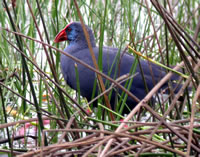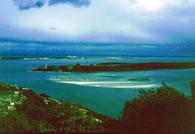 |
Southern reaches: Carrasqueira and
the Açude da Murta
From the northern outskirts of the village of Comporta, a track leads northwards
through a mosaic of rice fields, brackish pasture and small pools with fringing reedbeds, the
whole criss-crossed with ditches often choked by the highly invasive water hyacinth,
native to tropical America. This treeless expanse, known as the Sapal da Carrasqueira,
 Purple Gallinule
Purple Gallinule
Porphyrio porphyrio
© John Muddeman
is a favourite haunt of herons and egrets in winter, and is also home to a renowned winter
roost of short-eared owl. Reedbeds near the northern tip provide suitable habitat for
breeding water rail and Cetti's, reed and great reed warblers, with purple gallinule having
recently colonised the area, as well as attracting grasshopper and sedge warblers on passage;
winter brings an influx of marsh harriers and the occasional penduline tit.
On the seaward side of the Carrasqueira retaining wall lies one of the best examples of saltmarsh vegetation
in the estuary, carpeted with purple and perennial glassworts, annual and shrubby sea-blites, Arthrocnemum
macrostachyum, sea-purslane, small cord-grass, Spartina versicolor, common saltmarsh-grass and annual beard-grass,
and punctuated by stands of sea club-rush and patches of common sea-lavender, golden-samphire and the wormwood
Artemisia caerulescens; immediately below the low tide mark lie extensive meadows of eelgrass. In winter this
 Sado Estuary and the Tróia Peninsula
© Teresa Farino
area is often occupied by feeding black-necked grebes, greater flamingos, red-breasted mergansers and avocets,
with the taller saltmarsh vegetation providing a refuge for migratory bluethroats.
Sado Estuary and the Tróia Peninsula
© Teresa Farino
area is often occupied by feeding black-necked grebes, greater flamingos, red-breasted mergansers and avocets,
with the taller saltmarsh vegetation providing a refuge for migratory bluethroats.
On the southern margin of the estuary lies the Ašude da Murta: a narrow, artificially dammed freshwater lagoon
which has been declared an SPA (498ha) incorporating a 36ha Ramsar site. The waterbody is fringed with a belt
of common reed, bulrush, lesser bulrush, great fen-sedge, brown galingale, cyperus sedge and marsh fern, coloured
by bog-myrtle, marsh and wavy St John's-worts, purple-loosestrife, marsh pennywort, Myosotis lusitanica (endemic
to Portugal), yellow flag and water-plantain, with white and yellow water lilies, Hampshire purslane and rigid
hornwort in the water itself.
Common tree frog, western polecat and otter have been cited here, along with breeding little and cattle egrets,
purple heron (two pairs), little bittern, marsh harrier, water rail, nightingale, great reed, reed, Cetti's and
fan-tailed warblers and common waxbill. During passage periods, look out for squacco (has bred twice in the past
ten years) and night herons, plus penduline tit and reed bunting in winter. The lagoon is surrounded by one of
Portugal's largest stone pine forests, with breeding booted and short-toed eagles, great spotted cuckoo, lesser
spotted woodpecker, crested tit, short-toed treecreeper, woodchat shrike and azure-winged magpie (the latter now
considered a different species - Cyanopica cooki - from similar-looking relatives in eastern Asia).
|